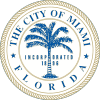Government of Miami
This article needs additional citations for verification. (May 2009) |

The government of the City of Miami, Florida is organized under the City Charter, which provides for a mayor-commissioner form of city government.
Organization[]
City Commission and Mayor[]

The Mayor of Miami, currently Francis X. Suarez, is the city's executive and is directly elected; the mayor appoints a city manager to act as Miami's chief administrative officer.
Five city commissioners are also elected from single-member districts of which they are residents. City commissioners also must be qualified voters. The City Commission holds regular meetings in Miami City Hall, located at 3500 Pan American Drive in the neighborhood of Coconut Grove. The Commission has the power to pass ordinances, adopt regulations, and exercise other powers. All city commission offices and that of the mayor are nonpartisan.[citation needed]
- Alex Diaz de la Portilla - Commissioner, District 1
- Ken Russell - Commissioner, District 2
- Joe Carollo - Commissioner, District 3
- Manolo Reyes - Commissioner, District 4
- Jefferey Watson - Commissioner, District 5
Police Department[]
The Miami Police Department (MPD), often referred to as the City of Miami Police, is the main police department of Miami. Their jurisdiction lies within the actual city limits of Miami, but have mutual aid agreements with neighboring police departments. Jorge Colina is the chief of police. City of Miami police are distinguishable from their Miami-Dade counterparts by their blue uniforms and blue-and-white patrol vehicles.
Water and Sewer Department[]
Water and sewer service in Miami is maintained by the Miami-Dade Water and Sewer Department.
Other[]
- - City Manager
- - City Attorney
- Todd B. Hannon - City Clerk
Federal and state representation[]
The United States Postal Service operates post offices in the city of Miami. The Miami Main Post Office, located at 2200 NW 72nd Avenue, is located outside of the city limits in unincorporated Miami-Dade County, adjacent to Miami International Airport.[1]
See also[]
References[]
- ^ "Post Office Location - MIAMI." United States Postal Service. Retrieved on May 5, 2009.
Bibliography[]
- Public Administration Service (1954), Government of Metropolitan Miami, Chicago – via HathiTrust

- Milan J. Dluhy and Howard A. Frank (2002). Miami Fiscal Crisis: Can a Poor City Regain Prosperity?. Praeger.
External links[]
- Government of Miami
- Local government in Florida
- Miami stubs
